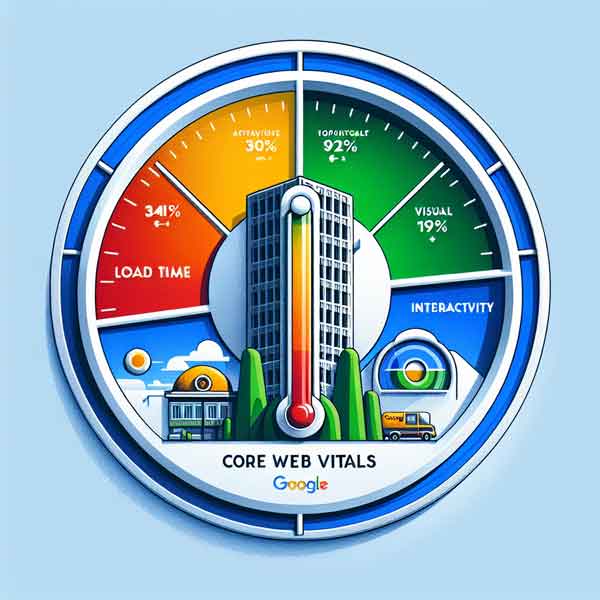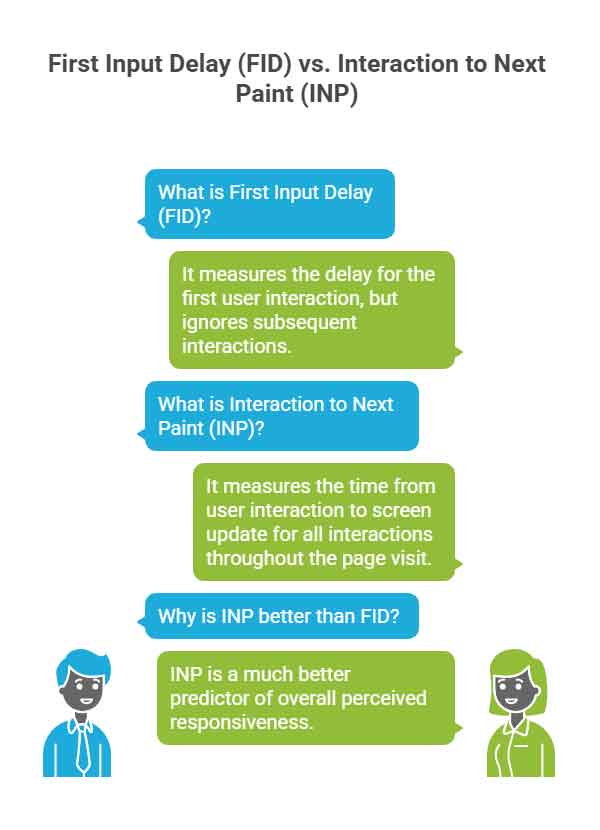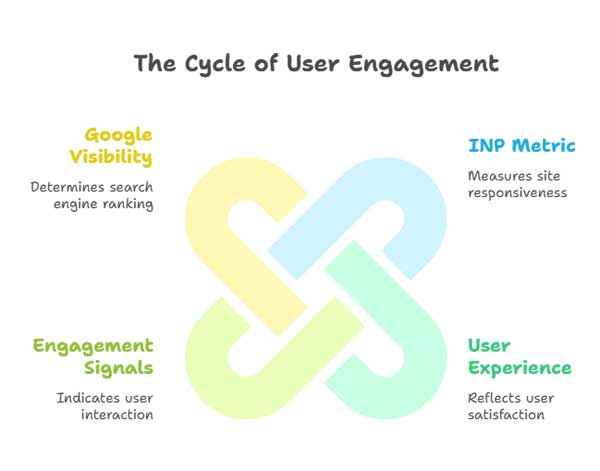I’ve been doing SEO for well over 20 years now, and it is almost unrecognizable the changes that have occurred during this time. The broader language of the ranking process is more aligned than it was, but when you break down the ranking factors, it can get pretty complicated. So let’s look at how web vitals in 2025 are important, and you should never ignore user experience, if you want a successful website.
For years, talking about SEO technicals felt like speaking a different language. “Meta tags!” “Backlinks!” “Keyword density!” We’d obsess over things the average user never even sees.
But a massive shift has happened. Google got smart. They realized the best way to rank a website isn’t to analyze its code in a vacuum, but to understand how real humans experience it.
Enter Core Web Vitals. They were Google’s first major attempt to quantify user experience (UX). You might remember the old trio: Loading (LCP), Interactivity (FID), and Visual Stability (CLS). They were a great start, but they had blind spots.

Well, the game has evolved. Welcome to Core Web Vitals 2025, where the stakes are higher, the metrics are smarter, and the message is clearer than ever: User Experience is SEO.
The Big Shift: From FID to INP
The most significant change on this journey is the retirement of First Input Delay (FID) and the full, unwavering adoption of Interaction to Next Paint (INP) as a Core Web Vital. This isn’t just a simple swap; it’s a major upgrade in how Google understands your site’s responsiveness.
So, what’s the difference?
- First Input Delay (FID) was a bit of a one-hit-wonder. It only measured the delay for the very first time a user interacted with your page (like clicking a link). The problem? It ignored every single interaction after that. A site could have a great FID but feel terribly sluggish as you continued to use it.
- Interaction to Next Paint (INP) is the holistic sequel. It observes all user interactions—every click, tap, and keyboard press—throughout the entire life of a page visit. It measures the time from when a user initiates an action until the browser actually updates the screen in response. According to Google’s own Chrome DevRel team, INP is a much better predictor of overall perceived responsiveness than FID ever was.

Think of it like this:
FID was a photo of a runner at the starting block.
INP is the full video of the entire race.
It captures the whole story of how your site feels to a user. A poor INP means buttons feel laggy, menus stutter open, and animations are janky. It feels bad, and in 2025, Google will be rewarding sites that feel good.
Why This Isn’t Just a Technicality: The UX-SEO Fusion
This move from FID to INP is the perfect case study in why user experience SEO is now the cornerstone of any successful strategy. Google’s mission is to provide the best, most satisfying results to its users. If your website is frustrating to use, why would Google send traffic its way?
It’s a direct correlation:
- A site with a good INP metric feels fast and responsive.
- A fast, responsive site creates a happy, engaged user.
- Happy users stay longer, convert more, and are less likely to bounce.
- Google sees these positive engagement signals and rewards the site with higher visibility.

It’s a virtuous cycle. You’re no longer optimizing for a robot; you’re optimizing for a person. The better the experience you create, the more both your users and Google will thank you for it.
Comparing the Old and the New: A Quick Guide
To really cement the evolution, let’s look at how the Core Web Vitals have matured. This table breaks down the key changes and what you need to focus on now.
| Metric | What It Was (The Old Guard) | What It Is Now (The 2025 Standard) | What It Means For You |
|---|---|---|---|
| Loading | LCP (Largest Contentful Paint) Time to load the main content. |
LCP (Largest Contentful Paint) Still the king of loading. Target: < 2.5s |
Optimize your hero images, web fonts, and server response times. |
| Interactivity | FID (First Input Delay) Delay on the first click/tap. |
INP (Interaction to Next Paint) Responsiveness for every interaction. Target: < 200ms |
Streamline JavaScript, break up long tasks, and avoid non-essential code on the main thread. |
| Visual Stability | CLS (Cumulative Layout Shift) Measures unexpected layout movement. |
CLS (Cumulative Layout Shift) Still crucial for stability. Target: < 0.1 |
Always define dimensions for images/videos, reserve space for ads, and avoid injecting content above existing content. |
As you can see, while LCP and CLS remain critical, the spotlight has firmly shifted to INP as the key indicator of a truly modern, high-quality website.
Implications and Insights: What This Dynamic Means for You
This isn’t just an academic exercise. The Core Web Vitals 2025 shift has real, practical implications for website owners, developers, and content creators.
- JavaScript is Front and Center: Since INP is primarily affected by how efficiently your browser executes JavaScript, poorly written or excessive JS is now your biggest enemy. This means auditing your third-party scripts, optimizing your code, and leveraging modern techniques like web workers to avoid blocking the main thread.
- It’s About the Whole Journey, Not Just the Landing: FID only cared about the first impression. INP cares about the entire user session. This means your “Contact Us” page, your product configurator, and your checkout flow are all just as important as your homepage. Every interaction on every page matters.
- Testing is Non-Negotiable: You can’t guess your way to a good INP score. You need to measure. Thankfully, Google provides a suite of fantastic free tools. Use PageSpeed Insights for a quick audit, CrUX (Chrome User Experience Report) to see real-world field data, and Lighthouse in Chrome DevTools for deep, actionable debugging guidance.
- The “Good” Threshold is Achievable, But Requires Work: Google’s target for a “good” INP is under 200 milliseconds. This is a tight budget! It forces developers to think critically about performance from the very beginning of a project, not as an afterthought. It encourages smarter architecture and a more disciplined approach to what code is shipped to the browser.
I must mention what I think is a weakness of web vitals within the search console. It may seem obvious but you do need significant traffic before you gain any metrics, to work on. In order to get that traffic, you must be doing something good in the first place, so it is more about fine tuning your processes to match your visitors better. But the basics need to be in place first, to have sufficeint traffic to register web essentials metrics.
Looking Ahead: The Future is Feelings
The introduction and prioritization of the INP metric is a clear signal of where search is headed. Google’s algorithms are increasingly sophisticated at measuring human satisfaction. They can’t feel frustration, but they can measure the digital footprints that frustration leaves behind: high bounce rates, low time on site, and abandoned carts.
In 2025 and beyond, the most successful websites won’t just be the ones with the best content or the most backlinks (though those are still important!). They will be the websites that offer the smoothest, most enjoyable, and most respectful user experience.
They will be the sites that feel instant.
They will be the sites where buttons respond without a second thought.
They will be the sites that don’t jolt you as an ad loads in.
By embracing Core Web Vitals 2025, you’re not just checking a box for SEO. You’re investing in your users. You’re building a faster, more resilient, and more successful website. And in the modern web, that’s the only strategy that truly matters.
